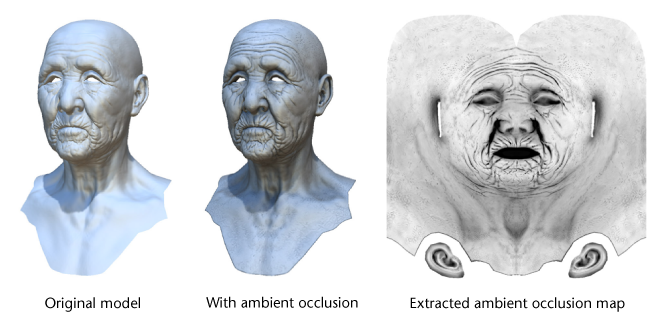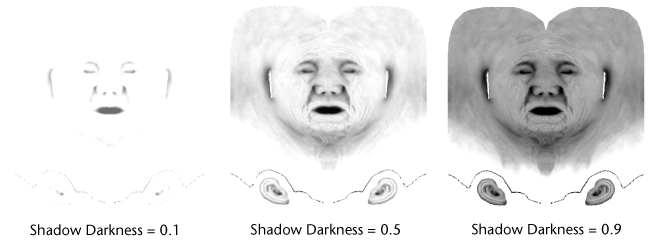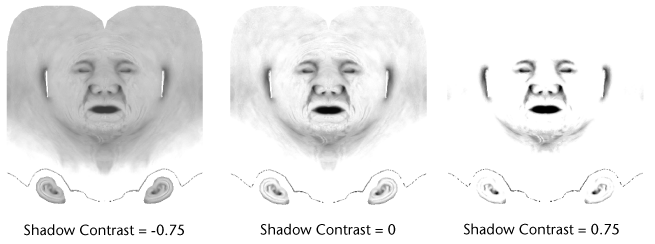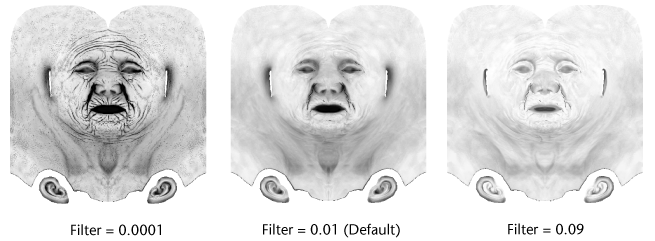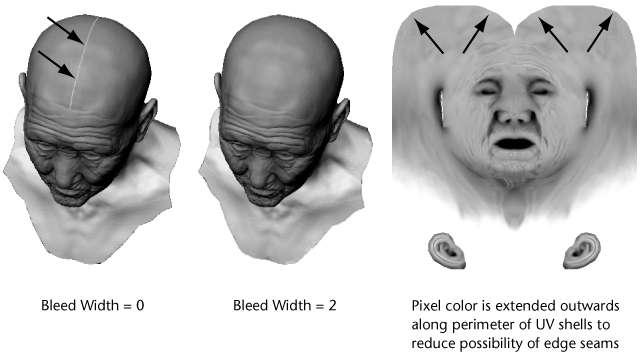Show in Contents

Add to Favorites

Home: Autodesk Mudbox Online Help

View normal maps on a model

Texture extraction

Troubleshoot texture extraction

Extract an ambient occlusion
map
Ambient occlusion is
a shading effect that calculates the attenuation and occlusion of
light between surface details and other objects in the scene and then
adds realistic shading to models.
You create ambient occlusion
maps using the Maps > Extract Ambient Occlusion Maps feature.
It calculates the ambient occlusion map based on the spatial relationships
between various items in the scene and creates a diffuse image map
that is automatically applied to the model(s) as a paint layer so you
can preview it before importing the texture map into another 3D
application.
This feature provides
a method for generating ambient occlusion image maps on extremely
high resolution models, in a variety of file formats, that would otherwise
be difficult to achieve using other 3D applications.
NoteWhen extracting ambient
occlusion maps on multiple objects simultaneously in the 3D
View each object should be assigned its own separate
shading material. Otherwise, the extracted map assigned to the default
material (which is assigned to all objects by default) appears on
all objects in the scene when you preview it. The exception for
this is when extracting a map from an asset that is comprised of
multiple objects and whose UVs are laid out in multiple UV tiles.
In these situations, assigning the same material to all objects
is required.
Ambient occlusion maps
can also be edited and enhanced directly in Mudbox, if necessary,
using the 3D paint tools.
- Select Maps
> Extract Ambient Occlusion Maps > New Operation.
The Extract
Ambient Occlusion window appears. For a complete description
of extraction properties see
Extract Ambient Occlusion Maps properties.
- Indicate the model(s) you want an ambient
occlusion map for by selecting its name in the Object
List or in 3D View using
the Objects selection tool (located
on the Select/Move Tools tray).
NoteIf a model is not
selected then an ambient occlusion map is produced for all objects
in the 3D View. Keep in mind that
all visible objects in the 3D View are
taken into account when calculating an ambient occlusion map. That
is, if you don’t want an object to be included as part of the ambient occlusion
calculations, hide it before extracting a map.
- Press either the Page
Up and Page Down keys to set the desired
subdivision level on the model(s) that you want the extraction to
occur.
Setting the subdivision
level on the model to its highest subdivision level provides the
most detailed ambient occlusion map possible. It is possible to
extract a map at lower subdivision levels, but fine detail will
not be extracted in the map and the appearance of facets because
of the lower resolution may result.
- In the Extract Ambient Occlusion window,
adjust any properties as required and click Extract:
NoteThe model must have
UV texture coordinates to extract an ambient occlusion map. Otherwise,
the following message appears when you click
Extract:
The model mesh has no UVs. Mudbox needs UVs
to generate Ambient Occlusion Maps. Try selecting Recreate Level
UVs under the Mesh menu. For more information, see
UVs overview.
- Quality -
Determines the quality of the final ambient occlusion map based on
multiple shadow maps that get used for the calculation.
- Image Size -
Specifies the height and width (in pixels) of the ambient occlusion
map(s) output.
- Base File Name -
Specifies the name of the extracted map(s).
TipThe first time you
extract an ambient occlusion map, set the Quality setting
to Fastest and Image
Size to a small resolution to quickly generate a test map.
Evaluate this initial test, adjust any settings as required, and
then set the Quality and Image
Size options to the final settings before generating
a final map.
The Advanced section,
contains the following properties:
- Shadow Map Resolution -
Controls the size of the shadow maps for the occlusion map calculations.
- Add as Paint Layer -
Automatically imports the generated ambient occlusion map as a new
paint layer within the Diffuse channel
of the assigned material. Turn this setting off if you don’t want
the ambient occlusion map assigned to a new paint layer.
- Shadow Darkness -
Controls the darkness of the shaded regions in the final ambient
occlusion map.
- Shadow Contrast -
Controls the contrast between shaded and non-shaded areas in the
ambient occlusion map.
- Filter -
Controls the filtering of the multiple shadow map calculations when
producing the final ambient occlusion map. To achieve sharp, finely detailed
shadows, set the Filter value to a low number
(0.0001). To produce a softer effect, set the Filter value
to a higher number.
- Bleed Width -
Specifies the width of the pixel border that automatically gets
added along the outside perimeter of each UV shell on the extracted map.
This reduces the possibility of seams occurring on the extracted
map where shell borders meet. The default width is one pixel.
- Skip Back Lights -
Lights situated behind the surface are not taken into account by
the ambient occlusion calculations when this option is turned on.
Otherwise back facing lights may affect the output. When on, this
feature provides the best extraction results under most circumstances.
The default is on.
A progress bar on the Status
Line indicates the progress of the extraction. Depending
on the Quality setting, this bar may
repeat the process several times as the feature calculates and composites
the necessary shadow maps.
The ambient occlusion
map is automatically applied to the model(s) as a diffuse paint
layer (provided the Add as Paint Layer property
is turned on) and positioned on top of any other existing paint
layers in the Diffuse channel.
If the model contains
UVs within multiple UV tile spaces, that is, outside the 0 to 1
range, the feature automatically creates separate ambient occlusion maps
that correlate to each UV tile and saves them to the user-specified
directory.
NoteIf your model contains
multiple UV tiles, each tile will appear in a different color after
the ambient occlusion map is applied to indicate that the textures
are currently unloaded. This is a graphics memory optimization feature.
For more information, see
Hide and show UV tiles on a model.
Edit an ambient occlusion
map
Once an ambient occlusion
map has been created and applied as a visible paint layer, you can
evaluate it and then make successive iterations by changing the
extraction settings then clicking extract, and previewing the updated version
again.
If you extract successive
ambient occlusion maps with the same file name it overwrites the
previous one and the paint layer is automatically updated in the 3D
View with the new map.
You can use the Paint tools
to modify or enhance the ambient occlusion map (add shading, erase
shading, and so on) because the map is applied a diffuse paint layer.
